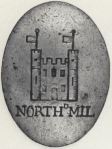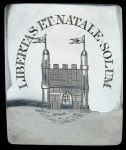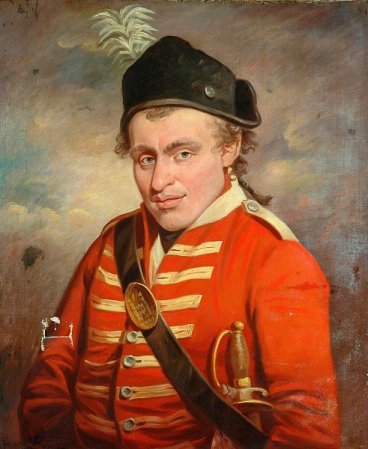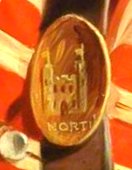Postscript – Man in Hat identified!
 Many thanks to Ralph C Spears, whose comment down below deserves pride of place up top here. Ralph writes:
Many thanks to Ralph C Spears, whose comment down below deserves pride of place up top here. Ralph writes:
I am pretty sure that the sergeant in the painting in “Who’s this? And what’s that hat?” is a member of the Northumberland Militia c 1803. See an image of the plate in JSAHR Vol 66 (1988) Page 97. The castle shown on the belt plate is Alnwick. The facings of the Northumberland Militia was light buff.
 And so indeed it proves, and here’s the plate in question. “NORTH” is actually “NORTHD” for Northumberland. And here’s an officer’s plate for comparison, courtesy of Paul Bantick.
And so indeed it proves, and here’s the plate in question. “NORTH” is actually “NORTHD” for Northumberland. And here’s an officer’s plate for comparison, courtesy of Paul Bantick.
The character of the hat is still a curiosity. While the black belt suggests that the Colonel accepted the tan leather accoutrements supplied by the Ordnance to Militia, rather than replacing them with whitened buff, as many did. And I still wonder why a sergeant would have had such a professional portrait done. Is he a figure of significance?
Anyway, here’s the original post …
* * *
Here’s a characterful little portrait – almost Falstaffian – lifted from the Art UK site, but held at Scarborough Art Gallery, where it is titled as “Major Tindall” and dated to circa 1745. That’s half a century too early, I think. Nor is this an officer. And the Lieutenant Colonel Tindall who commanded the Scarborough Volunteers of 1794 and 1803 (if that’s the thinking here) would have worn black facings. So who is it?

The single breasted jacket and the queued hair without powder suggest circa 1800 or a bit later, the black belt suggests a volunteer of the 1803 generation, and the sword suggests a sergeant, despite the absence of chevrons. The buff facings might indicate the volunteers of the neighbouring East Riding of Yorkshire, from among whom the word “North” on the belt plate might designate the North Holderness Volunteers – the only volunteer corps in the North or East Riding with that word in their title. (And North Holderness is only a stone’s throw from Scarborough.) The plain lace loops might be for a sergeant or a volunteer style as discussed in this post. (The lace here appears buff rather than white, though no regulation supports that for a sergeant of a buff faced corps.)
 So, a sergeant of the North Holderness – well, maybe, though I could be well off target. But the whole effect is strangely agricultural. Wouldn’t you button up your jacket for a portrait? And how many sergeants could afford to have themselves limned for posterity, and by quite a competent painter, too? And what’s with the hat? Were no dress caps available? It has the look of an old hat cut down for a forage cap, with just a flap surviving to fold up at the back. So why the lone button at one side, and the feather (and cockade?) at the other? And was a castle emblematic of the Holderness area?
So, a sergeant of the North Holderness – well, maybe, though I could be well off target. But the whole effect is strangely agricultural. Wouldn’t you button up your jacket for a portrait? And how many sergeants could afford to have themselves limned for posterity, and by quite a competent painter, too? And what’s with the hat? Were no dress caps available? It has the look of an old hat cut down for a forage cap, with just a flap surviving to fold up at the back. So why the lone button at one side, and the feather (and cockade?) at the other? And was a castle emblematic of the Holderness area?
Skipsea Castle (demolished)? Flamborough (virtually
demolished)? I’m not convinced.
In the unlikely event that anyone stumbling across this can shed any further light, I’d love to hear about it.
